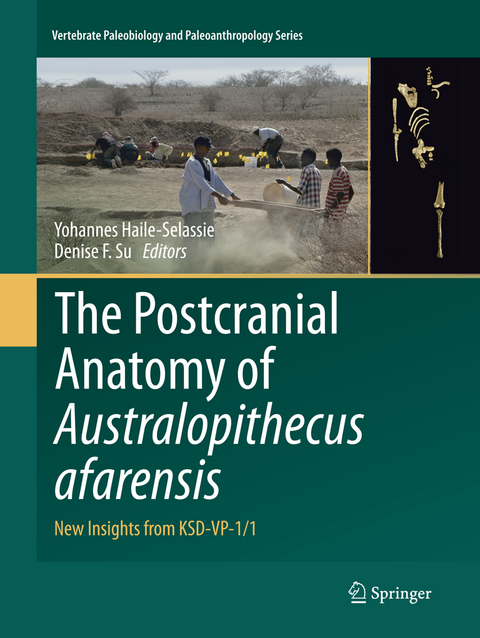
The Postcranial Anatomy of Australopithecus afarensis
Springer (Verlag)
978-94-024-1347-2 (ISBN)
Dr. Yohannes Haile-Selassie is curator and head of Physical Anthropology at The Cleveland Museum of Natural History. His main area of research is Plio-Miocene mammalian evolution with a focus on the origin of the earliest hominins and the evolutionary history of early Australopithecus. He is also principal investigator of an active fieldwork project in Ethiopia, the Woranso-Mille paleontological project. Scientists from Ethiopia, Europe, and various institutions in the United States collaborate on a variety of subdisciplines of geology and paleontology. His collaborative fieldwork is shedding new light on the diversity and relationships among the earliest Australopithecus species and evolution of numerous extinct and extant mammalian taxa. As a member of the Middle Awash project (1993 – 2007), Haile-Selassie has discovered some of the most important hominin fossils known to science. Among these are the holotype of the 2.5 million-year-old Australopithecus garhi, the first pieces of the 4.4 million-year-old Ardipithecus ramidus partial skeleton, nicknamed "Ardi," and fossil remains of the 5.8 million-year-old Ardipithecus kadabba. He has recently co-edited a monograph on the latter species, which he named in 2001. Haile-Selassie is a fellow of the American Association for the Advancement of Science, and fellow of the Institute for the Science of Origins at Case Western Reserve University. He is also adjunct professor in the Departments of Anthropology, Anatomy, and Cognitive Sciences at Case Western Reserve University, where he teaches human evolution course. Dr. Denise Su is the Curator of Paleobotany and Paleoecology at the Cleveland Museum of Natural History. Her main area of research is the paleoecology of early hominins; she seeks to better understand the environmental context in which early hominins evolved to better address origination, extinction and adaptation events in our lineage. She conducts fieldwork at Laetoli, Tanzania, an important Pliocene hominin site where footprint trails of Australopithecus afarensis was discovered in 1976 and has reconstructed its paleoecological conditions using multi-evidential approach. She has also studied the paleoecology of other key early hominin localities, such as Aramis and West Margin of the Middle Awash, where Ardipithecus ramidus and Ardipithecus kadabba were recovered, respectively.
Introduction to KSD-VP-1/1: The earliest partial skeleton of Australopithecus afarensis.- The Geologic Context of Korsi Dora and the Partial Skeleton KSD-VP-1/1.- The Taphonomy and Paleoecology of Korsi Dora Vertebrate Locality 1, Woranso-Mille Study Area, Ethiopia.- KSD-VP-1/1: Analysis of the Postcranial Skeleton Using High-Resolution Computed Tomography.- The Cervical Vertebrae of KSD-VP-1/1.- The Shoulder Girdle of KSD-VP-1/1.- The Thoracic Cage of KSD-VP-1/1.- The Pelvic Girdle and Limb Bones of KSD-VP-1/1.- Conclusion: Implications of KSD-VP-1/1 for Early Hominin Paleobiology and Insights into the Chimpanzee/Human Last Common Ancestor.
| Erscheinungsdatum | 18.06.2018 |
|---|---|
| Reihe/Serie | Vertebrate Paleobiology and Paleoanthropology |
| Zusatzinfo | 82 Illustrations, color; 24 Illustrations, black and white; XI, 191 p. 106 illus., 82 illus. in color. |
| Verlagsort | Dordrecht |
| Sprache | englisch |
| Maße | 210 x 279 mm |
| Themenwelt | Geisteswissenschaften ► Archäologie |
| Naturwissenschaften ► Biologie ► Evolution | |
| Naturwissenschaften ► Geowissenschaften ► Mineralogie / Paläontologie | |
| Sozialwissenschaften ► Ethnologie | |
| Sozialwissenschaften ► Soziologie | |
| ISBN-10 | 94-024-1347-2 / 9402413472 |
| ISBN-13 | 978-94-024-1347-2 / 9789402413472 |
| Zustand | Neuware |
| Informationen gemäß Produktsicherheitsverordnung (GPSR) | |
| Haben Sie eine Frage zum Produkt? |
aus dem Bereich


